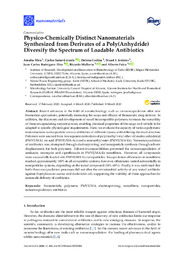Título :
Physico-Chemically Distinct Nanomaterials Synthesized from Derivates of a Poly(Anhydride) Diversify the Spectrum of Loadable Antibiotics |
Autor :
Mira Carrió, Amalia
Sainz Urruela, Carlos
Codina Márquez, Helena
Jenkins, Stuart I.
Rodríguez Díaz, Juan Carlos
Mallavia Marín, Ricardo
Falcó Graciá, Juan Alberto |
Fecha de publicación:
2020-03-06 |
URI :
http://hdl.handle.net/11000/6895 |
Resumen :
Recent advances in the field of nanotechnology such as nanoencapsulation offer new biomedical applications, potentially increasing the scope and efficacy of therapeutic drug delivery. In addition, the discovery and development of novel biocompatible polymers increases the versatility of these encapsulating nanostructures, enabling chemical properties of the cargo and vehicle to be adapted to specific physiological requirements. Here, we evaluate the capacity of various polymeric nanostructures to encapsulate various antibiotics of different classes, with differing chemical structure. Polymers were sourced from two separate derivatives of poly(methyl vinyl ether-alt-maleic anhydride) (PMVE/MA): an acid (PMVE/MA-Ac) and a monoethyl ester (PMVE/MA-Es). Nanoencapsulation of antibiotics was attempted through electrospinning, and nanoparticle synthesis through solvent displacement, for both polymers. Solvent incompatibilities prevented the nanoencapsulation of amikacin, neomycin and ciprofloxacin in PMVE/MA-Es nanofibers. However, all compounds were successfully loaded into PMVE/MA-Es nanoparticles. Encapsulation efficiencies in nanofibers reached approximately 100% in all compatible systems; however, efficiencies varied substantially in nanoparticles systems, depending on the tested compound (14%–69%). Finally, it was confirmed that both these encapsulation processes did not alter the antimicrobial activity of any tested antibiotic against Staphylococcus aureus and Escherichia coli, supporting the viability of these approaches for nanoscale delivery of antibiotics
|
Palabras clave/Materias:
biomaterials
polymers
PMVE/MA
electrospinning
nanofibers
nanoparticles
nanoencapsulation
antibiotics |
Tipo documento :
application/pdf |
Derechos de acceso:
info:eu-repo/semantics/openAccess |
DOI :
https://doi.org/10.3390/nano10030486 |
Aparece en las colecciones:
Instituto de Investigación, Desarrollo e Innovación en Biotecnología Sanitaria de Elche
|

 La licencia se describe como: Atribución-NonComercial-NoDerivada 4.0 Internacional.
La licencia se describe como: Atribución-NonComercial-NoDerivada 4.0 Internacional.
.png)